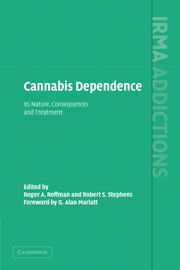Book contents
- Frontmatter
- Contents
- List of Contributors
- Acknowledgments
- Executive Summary
- Foreword
- Part I The Nature of Cannabis Dependence
- Part II Interventions with Cannabis-Dependent Adults
- 6 Cognitive-Behavioral and Motivational Enhancement Treatments for Cannabis Dependence
- 7 Contingency-Management Interventions for Cannabis Dependence
- 8 The Marijuana Check-Up
- 9 Guided Self-Change: A Brief Motivational Intervention for Cannabis Abuse
- 10 Supportive–Expressive Psychotherapy for Cannabis Dependence
- Part III Interventions with Cannabis-Dependent Adolescents and Young Adults
- Part IV Policy
- Part V Conclusion
- Index
9 - Guided Self-Change: A Brief Motivational Intervention for Cannabis Abuse
from Part II - Interventions with Cannabis-Dependent Adults
Published online by Cambridge University Press: 29 October 2009
- Frontmatter
- Contents
- List of Contributors
- Acknowledgments
- Executive Summary
- Foreword
- Part I The Nature of Cannabis Dependence
- Part II Interventions with Cannabis-Dependent Adults
- 6 Cognitive-Behavioral and Motivational Enhancement Treatments for Cannabis Dependence
- 7 Contingency-Management Interventions for Cannabis Dependence
- 8 The Marijuana Check-Up
- 9 Guided Self-Change: A Brief Motivational Intervention for Cannabis Abuse
- 10 Supportive–Expressive Psychotherapy for Cannabis Dependence
- Part III Interventions with Cannabis-Dependent Adolescents and Young Adults
- Part IV Policy
- Part V Conclusion
- Index
Summary
Studies of treated cannabis abusers (Ellingstad et al., 2002; Sobell et al., 1990; Stephens et al., 2000) and those who have recovered without treatment (L.C. Sobell et al., 2000) are few in number compared with studies of other drug abusers. Since national surveys have repeatedly shown that cannabis is the most widely used illicit drug (Substance Abuse and Mental Health Services Administration, 1997, 1998, 2000a, b) this finding is somewhat counterintuitive. In fact, a recent review of drug treatment studies found that only 8% (2 of 28) that met review criteria included primary cannabis abusers in their treatment samples (Ellingstad et al., 2002). Further, a review of natural recovery studies found that only 1 of 40 reported data from cannabis abusers (L.C. Sobell et al., 2000).
Prevalence
Given cannabis popularity, an interesting question is why only about half a million of the 6.8 million frequent cannabis users (defined as using cannabis ≥ 50 times) enter treatment (Substance Abuse and Mental Health Services Administration, 2000a). One possible reason is that compared with other illicit drugs, the negative consequences of cannabis use are fewer, and if they occur, are much less severe. For example, most of those who initiate abstinence from cannabis do not report severe withdrawal symptoms (Budney et al., 2001; Wiesbeck et al., 1996; Zimmer & Morgan, 1995) and the most frequently reported problems appear more related to personal dissatisfaction with drug use rather than objective negative consequences (Stephens et al., 1994, 2000).
Keywords
- Type
- Chapter
- Information
- Cannabis DependenceIts Nature, Consequences and Treatment, pp. 204 - 224Publisher: Cambridge University PressPrint publication year: 2006
- 1
- Cited by

